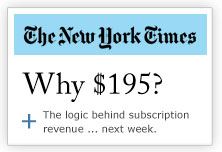
Here is one way to understand the $195 price of a 12-month digital subscription to the New York Times. The price bridges the 2010 gap between average revenue per user (ARPU) for print vs. the ARPU for online. Here is the calculation of the difference. Print ARPU The Newspaper Association of America Trends & Numbers provides details on audience and revenues for US newspapers. Users of print are determined from the print readership which was 152,245,119 in 2010 according to Scarborough Research. Revenue of print is determined from a combination of the advertising and circulation revenues. The print advertising revenue in 2010 was $22,795,000,000. While 2010 circulation revenues have not been provided, most analysts expect them to remain flat compared […]






